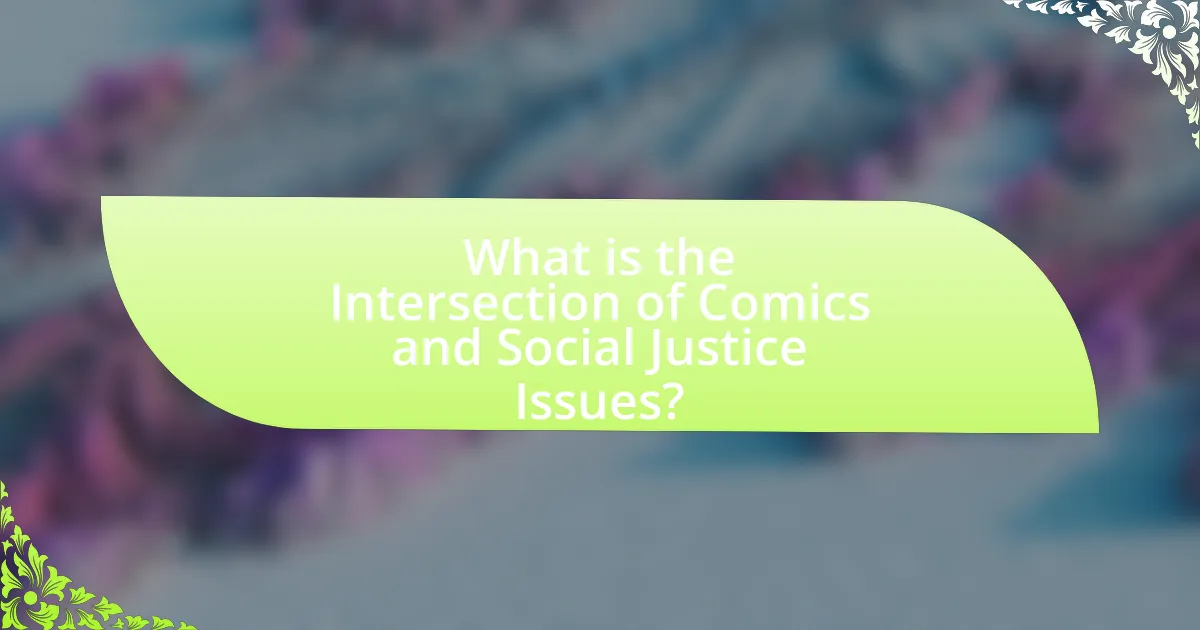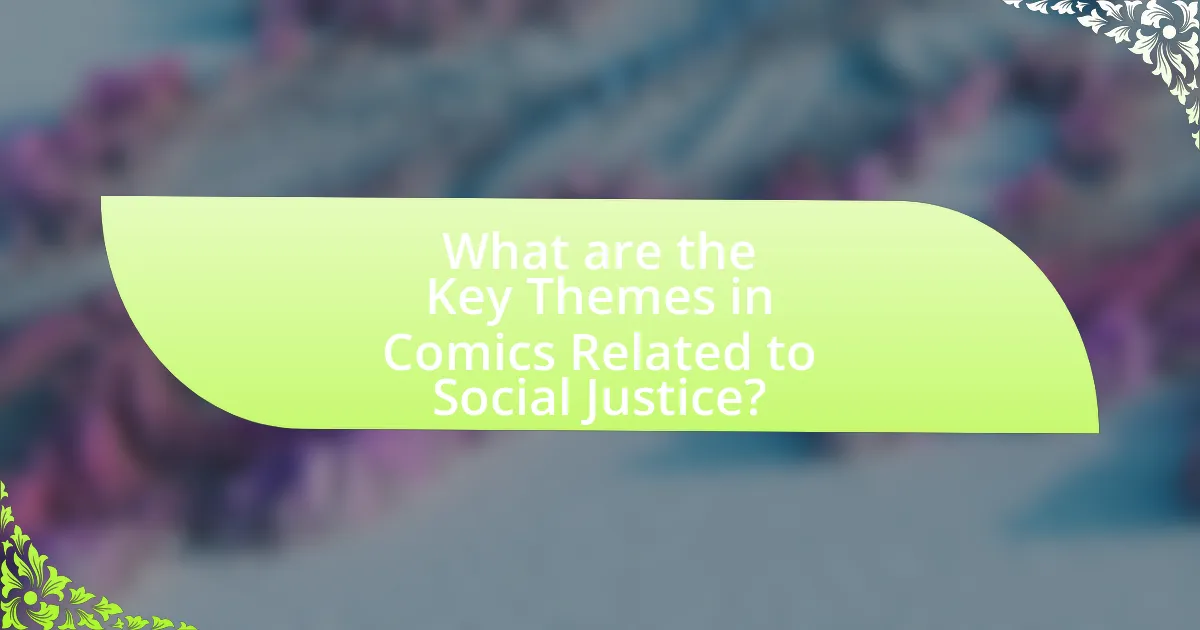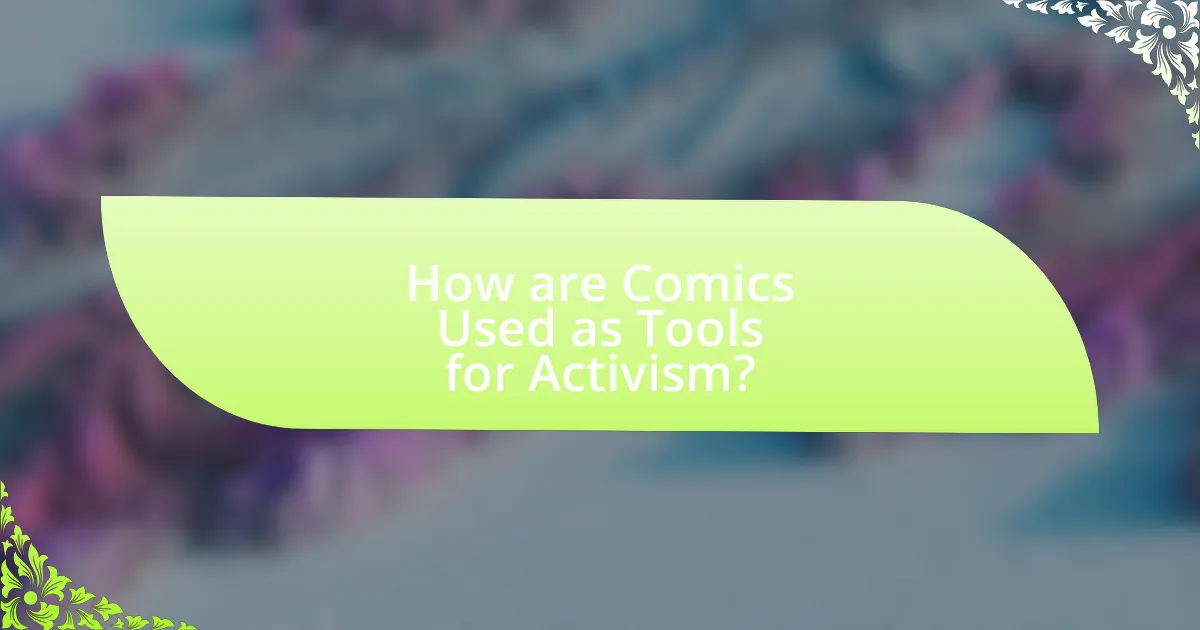The article explores the intersection of comics and social justice issues, highlighting how this medium addresses societal challenges, advocates for marginalized voices, and inspires activism. It discusses the historical context of comics in social justice, the effectiveness of visual storytelling in conveying complex themes, and the representation of diverse identities across various genres. Key themes such as activism, intersectionality, and the portrayal of race, gender, and sexuality are examined, alongside the role of comics in promoting awareness and fostering discussions around social justice. Additionally, the article outlines strategies employed by creators to engage audiences and support activism through comics.

What is the Intersection of Comics and Social Justice Issues?
The intersection of comics and social justice issues lies in the medium’s ability to address and reflect societal challenges, advocate for marginalized voices, and inspire activism. Comics have historically tackled themes such as racism, gender equality, and LGBTQ+ rights, exemplified by works like “Maus” by Art Spiegelman, which confronts the Holocaust, and “March” by John Lewis, which chronicles the Civil Rights Movement. These narratives not only entertain but also educate readers about social injustices, making the medium a powerful tool for social change.
How do comics serve as a medium for social justice narratives?
Comics serve as a powerful medium for social justice narratives by combining visual storytelling with accessible language to convey complex social issues. This format allows creators to illustrate injustices, raise awareness, and foster empathy among diverse audiences. For instance, graphic novels like “March” by John Lewis depict the Civil Rights Movement, providing historical context and personal experiences that resonate emotionally with readers. Additionally, studies show that visual narratives can enhance understanding and retention of social justice themes, making comics an effective tool for education and activism.
What historical context supports the use of comics in social justice?
The historical context supporting the use of comics in social justice includes the emergence of political cartoons in the 18th and 19th centuries, which critiqued social issues and government policies. For instance, during the civil rights movement in the 1960s, comics like “Martin Luther King and the Montgomery Story” were used to educate and mobilize activists, illustrating the struggles for racial equality. Additionally, the underground comix movement of the 1960s and 1970s addressed countercultural themes, including anti-war sentiments and LGBTQ+ rights, further solidifying comics as a medium for social commentary. These examples demonstrate how comics have historically served as a platform for advocating social change and raising awareness about injustices.
How have different genres of comics addressed social justice themes?
Different genres of comics have addressed social justice themes by using narrative and visual storytelling to highlight issues such as racism, gender equality, and LGBTQ+ rights. For instance, superhero comics often depict characters fighting against oppression, as seen in works like “Black Panther,” which explores themes of racial identity and empowerment. Additionally, independent comics, such as “Fun Home” by Alison Bechdel, tackle personal and societal issues related to sexual orientation and family dynamics, providing a platform for marginalized voices. Historical comics, like “March” by John Lewis, document civil rights movements, illustrating the struggles and triumphs of activists. These examples demonstrate how various comic genres serve as vehicles for social commentary and advocacy, effectively engaging audiences in critical conversations about justice and equality.
Why is it important to explore social justice through comics?
Exploring social justice through comics is important because comics serve as an accessible medium that can effectively communicate complex social issues to a diverse audience. The visual storytelling format of comics allows for the simplification of intricate topics, making them relatable and engaging. For instance, works like “March” by John Lewis illustrate the Civil Rights Movement, providing historical context and emotional resonance that can inspire activism and awareness. This combination of visual art and narrative not only educates readers but also fosters empathy, encouraging discussions around social justice themes such as inequality, discrimination, and human rights.
What impact do comics have on public perception of social issues?
Comics significantly influence public perception of social issues by providing accessible narratives that engage readers emotionally and intellectually. They often simplify complex topics, making them relatable and easier to understand, which can lead to increased awareness and empathy. For instance, works like “Maus” by Art Spiegelman and “Persepolis” by Marjane Satrapi have brought attention to the Holocaust and the Iranian Revolution, respectively, illustrating how personal stories can humanize broader social issues. Research indicates that visual storytelling in comics can enhance retention of information and foster discussions around social justice, as evidenced by studies showing that graphic novels are effective educational tools in classrooms.
How do comics engage diverse audiences in social justice discussions?
Comics engage diverse audiences in social justice discussions by utilizing visual storytelling to convey complex issues in an accessible format. This medium allows for the representation of varied perspectives, making it easier for readers from different backgrounds to connect with the narratives. For instance, graphic novels like “March” by John Lewis illustrate the Civil Rights Movement, providing historical context while fostering empathy and understanding among readers. Additionally, comics often incorporate humor and satire, which can disarm difficult topics, encouraging dialogue and reflection on social justice issues. Studies show that visual narratives can enhance retention and comprehension, making them effective tools for education and advocacy in social justice contexts.

What are the Key Themes in Comics Related to Social Justice?
Key themes in comics related to social justice include representation, activism, and intersectionality. Representation focuses on depicting diverse characters and narratives that reflect marginalized communities, such as racial minorities, LGBTQ+ individuals, and people with disabilities. Activism is often portrayed through storylines that encourage social change, highlighting issues like police brutality, climate change, and economic inequality. Intersectionality examines how various social identities overlap and impact individuals’ experiences, emphasizing the complexity of social justice issues. These themes are supported by numerous comic series, such as “Ms. Marvel,” which features a Muslim superhero, and “Black Panther,” which addresses themes of race and empowerment.
How do comics address issues of race and identity?
Comics address issues of race and identity by using diverse characters and narratives that reflect the complexities of racial experiences. For example, titles like “Black Panther” and “Ms. Marvel” showcase protagonists from underrepresented backgrounds, allowing readers to engage with themes of cultural identity and social justice. These comics often tackle systemic racism, identity struggles, and the quest for belonging, providing a platform for marginalized voices. The impact of these narratives is evident in the increased visibility of racial issues in popular culture, as seen in the success of graphic novels that explore personal and collective histories, such as “March” by John Lewis, which chronicles the Civil Rights Movement. This integration of race and identity in comics not only entertains but also educates readers about social issues, fostering empathy and understanding.
What are notable examples of comics that tackle racial injustice?
Notable examples of comics that tackle racial injustice include “March” by John Lewis, which chronicles the civil rights movement through the experiences of the late Congressman Lewis, and “The Black Panther” series, particularly the 2016 run by Ta-Nehisi Coates, which addresses themes of race, identity, and power dynamics in a fictional African nation. Additionally, “American Born Chinese” by Gene Luen Yang explores the complexities of Asian American identity and racial stereotypes. These comics provide critical commentary on racial issues, reflecting real-world struggles and historical contexts.
How do creators use personal narratives to highlight racial issues?
Creators use personal narratives to highlight racial issues by sharing their lived experiences, which provide authentic insights into the challenges faced by marginalized communities. These narratives often include specific instances of discrimination, cultural identity struggles, and systemic injustices, allowing audiences to connect emotionally and intellectually with the realities of racial issues. For example, graphic novels like “March” by John Lewis illustrate the Civil Rights Movement through personal stories, effectively conveying the historical context and emotional weight of racial struggles. This approach not only raises awareness but also fosters empathy, encouraging readers to reflect on their own perspectives regarding race and social justice.
In what ways do comics explore gender and sexuality issues?
Comics explore gender and sexuality issues through diverse narratives, character representations, and thematic elements that challenge societal norms. For instance, many comics feature LGBTQ+ characters and storylines that address identity, acceptance, and discrimination, such as “Fun Home” by Alison Bechdel, which delves into the author’s experiences with her sexual orientation and family dynamics. Additionally, comics like “Ms. Marvel” by G. Willow Wilson introduce characters who navigate cultural and gender identities, reflecting the complexities of modern society. These works not only entertain but also provoke discussions about gender roles and sexual orientation, contributing to broader social justice movements.
What role do female characters play in advocating for gender equality?
Female characters play a crucial role in advocating for gender equality by challenging stereotypes and promoting empowerment within narratives. These characters often serve as symbols of resilience and strength, illustrating the complexities of women’s experiences and their fight for equal rights. For instance, characters like Wonder Woman and Ms. Marvel not only embody feminist ideals but also inspire readers to question societal norms and advocate for change. Research indicates that representation of strong female characters in media can positively influence perceptions of gender roles, as seen in studies conducted by the Geena Davis Institute on Gender in Media, which found that diverse female portrayals lead to greater acceptance of gender equality among audiences.
How do LGBTQ+ themes manifest in contemporary comics?
LGBTQ+ themes manifest in contemporary comics through diverse representation, storytelling, and character development that reflect the complexities of queer identities. Comics such as “Saga” by Brian K. Vaughan and Fiona Staples feature prominent LGBTQ+ characters and relationships, showcasing their experiences in a fantastical setting while addressing real-world issues like acceptance and discrimination. Additionally, titles like “The Avant-Guards” by Carly Usdin highlight the importance of community and support within LGBTQ+ spaces, emphasizing themes of friendship and love. The increasing visibility of LGBTQ+ creators in the comic industry further enriches these narratives, allowing for authentic voices and experiences to be shared, as seen in works by creators like Mariko Tamaki and Noelle Stevenson. This representation not only fosters inclusivity but also challenges societal norms, making contemporary comics a vital medium for LGBTQ+ advocacy and awareness.

How are Comics Used as Tools for Activism?
Comics are used as tools for activism by conveying social justice messages through visual storytelling, making complex issues accessible and engaging to a broad audience. For instance, graphic novels like “Maus” by Art Spiegelman and “Persepolis” by Marjane Satrapi address themes of genocide and oppression, respectively, illustrating the power of personal narratives in raising awareness. Additionally, organizations like the Comic Book Legal Defense Fund advocate for free expression and support creators facing censorship, demonstrating how comics can mobilize communities around critical social issues.
What strategies do comic creators employ to promote social change?
Comic creators employ various strategies to promote social change, including storytelling that highlights social issues, character development that reflects diverse experiences, and collaboration with activists. By using narrative arcs that engage readers emotionally, creators can raise awareness about topics such as racism, gender equality, and mental health. For instance, works like “March” by John Lewis illustrate the civil rights movement, effectively educating audiences on historical injustices. Additionally, creators often incorporate real-life events and figures into their comics, making the content relatable and impactful. Collaborations with social justice organizations further amplify their messages, as seen in projects like “The New Adventures of Wonder Woman,” which addressed feminist issues. These strategies collectively foster dialogue and inspire action among readers.
How do grassroots movements utilize comics for awareness campaigns?
Grassroots movements utilize comics for awareness campaigns by leveraging the visual storytelling medium to convey complex social issues in an accessible format. Comics can simplify intricate topics, making them relatable and engaging for diverse audiences, which is crucial for mobilizing support and fostering understanding. For instance, organizations like the Comic Book Legal Defense Fund have used comics to address censorship and free speech, effectively reaching a broader demographic. Additionally, studies have shown that visual narratives can enhance retention of information, making comics an effective tool for education and advocacy in social justice movements.
What role do webcomics play in modern activism?
Webcomics serve as a powerful medium for modern activism by providing accessible platforms for marginalized voices and social issues. They allow creators to express complex ideas and narratives in a visually engaging format, making activism relatable and digestible for a wider audience. For instance, webcomics like “Sarah’s Scribbles” and “The Oatmeal” often tackle social justice themes, raising awareness about mental health, gender equality, and environmental issues. The immediacy of online distribution enables rapid dissemination of these messages, fostering community engagement and dialogue. Additionally, studies have shown that visual storytelling can enhance empathy and understanding, making webcomics an effective tool for advocacy and education in contemporary social movements.
How can readers engage with comics that focus on social justice?
Readers can engage with comics that focus on social justice by actively participating in discussions, sharing their perspectives, and supporting creators. Engaging in discussions can occur through online forums, social media platforms, or local book clubs, where readers can analyze themes and narratives that address social justice issues. Sharing perspectives allows readers to connect with others who may have different viewpoints, fostering a deeper understanding of the topics presented in the comics. Supporting creators can involve purchasing their work, attending events, or promoting their projects, which helps sustain the production of socially conscious comics. This engagement not only enhances the reading experience but also contributes to broader conversations about social justice in society.
What resources are available for finding socially conscious comics?
Resources for finding socially conscious comics include online platforms like ComiXology, which features a diverse range of titles addressing social issues, and independent publishers such as First Second Books, known for their commitment to social justice themes. Additionally, websites like The Comics Journal and Graphic Policy provide reviews and discussions on comics that tackle societal topics. Libraries often have curated collections focusing on graphic novels that engage with social justice, and organizations like the Comic Book Legal Defense Fund promote comics that address important social issues. These resources collectively offer access to a wide array of socially conscious comics, ensuring readers can find material that resonates with social justice themes.
How can readers support creators who focus on social justice themes?
Readers can support creators who focus on social justice themes by purchasing their work, sharing their content on social media, and engaging in discussions about the issues presented. Financial support through buying comics or merchandise directly contributes to the creators’ ability to continue their work. Sharing content amplifies the creators’ messages and reaches a broader audience, fostering awareness and dialogue around social justice issues. Engaging in discussions helps to create a community that values and promotes the themes explored in the creators’ work, further validating their efforts and encouraging more creators to address these important topics.
What are best practices for creating comics that address social justice issues?
Best practices for creating comics that address social justice issues include thorough research, authentic representation, and collaboration with affected communities. Thorough research ensures that the comic accurately reflects the social justice issue being addressed, providing context and depth. Authentic representation involves portraying characters and narratives that reflect the diversity and complexity of real-life experiences, avoiding stereotypes and clichés. Collaboration with affected communities allows creators to gain insights and perspectives that enhance the comic’s authenticity and impact. For instance, comics like “March” by John Lewis exemplify these practices by combining personal narrative with historical context, effectively engaging readers in social justice discourse.
